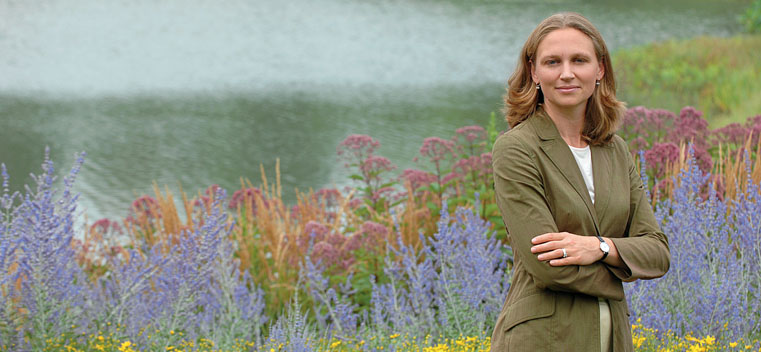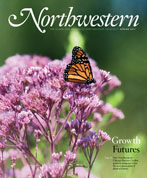
Plants and Plans
The Chicago Botanic Garden announced a 10-year strategic plan last spring, but president and CEO Sophia Siskel (KSM99) has a longer-range plan in mind for the Garden’s future.
“Here at the Chicago Botanic Garden, we see ourselves as stewards,” she says. “We’re responsible for stewarding an organization that will be here 500 years from now.” She compares it to the Garden of Padova in Italy, which was founded in 1545 and is still in operation. By that yardstick the 39-year-old Chicago Botanic Garden is still just a sapling.
Siskel hopes to keep the Garden growing, increase its educational programs and enable its research scientists to save hundreds of native plants in the Midwest for generations to come. The $250 million master plan she announced last April calls for the creation of a new entrance to the Garden, a children’s learning campus, rebuilt greenhouses, reconfigured parking and a miles-long extension to the Cook County Forest Preserve bike-walking path.
Since being named the Chicago Botanic Garden president and CEO in 2007, Siskel has managed a $27 million budget and 500 employees and has presided over the building of the state-of-the-art, $50.9 million Daniel F. and Ada L. Rice Plant Conservation Science Center, expanding the Garden’s research and science education programs and putting it at the forefront of plant conservation science.
Though already respected as a teaching and plant science research center, the Garden is now becoming the nation’s leading center for training the next generation of scientists, restoration ecologists, land managers and policymakers, thanks to the creation of the joint plant biology and conservation master’s and doctoral programs with Northwestern University in 2005 and 2009, respectively.
Siskel credits Northwestern University provost Dan Linzer (then dean of the Weinberg College of Arts and Sciences) and her predecessor, former Garden president and CEO Barbara Carr, for their vision in developing the joint program.
“The partnership speaks volumes about our Midwestern sensibility, the way this relationship has grown and flourished,” she notes. “What’s so nice about the Chicago Botanic Garden–Northwestern partnership is that it not only benefits our institutions beautifully, it benefits the world. These botanists and conservation biologists could not get this training anywhere else.”
When she first took the helm, Siskel was charged with building the Garden’s reputation as a leader in hard science, not just as a place with pretty flowers.
“We were struggling as an institution with the concept that people thought the Garden was just another pretty place,” explains Siskel. “Then we invested in plant science, and it’s wonderful. Now we say, ‘Yes, we’re a really pretty place, but we’re also a smart, important place.’ We can be both.”
Siskel worked as vice president of exhibitions and education at Chicago’s Field Museum and as an assistant curator at the Museum of Contemporary Art before joining the Garden as vice president of visitor programs and operations in 2006.
A committed gardener herself, Siskel is passionate in her belief in the transformative nature of plants.
“The world will go on without us,” she concludes. “But for us to exist on Earth happily, we need to save the Earth’s plants. All life depends on plants, not just to satisfy basic needs but for beauty, for joy, for inspiration, for our health, for bringing our families together, for work, for jobs. “For it is with this connection to nature that we can bring out the best in ourselves.” — S.R.



 Facebook
Facebook Twitter
Twitter Email
Email


